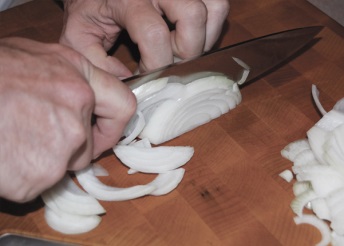Mastering the art of slicing and dicing vegetables
A skilled chef or cook knows the importance of mastering the art of slicing and dicing vegetables. With emphasis on a healthier diet, this art is something everyone should learn how to do.
Cooking and preparing meals requires skills that many of our grandmother’s and mother’s may have taught us. But if you haven’t had that preparation lesson, then this information may interest you. A skilled chef or cook knows the importance of mastering the art of slicing and dicing vegetables. Michigan State University Extension says that an emphasis on a healthier diet includes daily servings of vegetables and fruit, which may require some slicing and dicing. Slicing and dicing is one of the several basic skills you use in the kitchen and is something everyone should learn how to do.
First, you will need a good sharp knife and a sturdy, clean cutting board. Having the same size and shape food product ensures that foods will cook evenly. Items are shaped by slicing, chopping, dicing, mincing and other special cutting techniques. Chopping is cutting an item into small pieces; size and shape are not important. This is much easier than the other ways of cutting.
Here are some simple instructions to get you started:
- Prepare the vegetables before slicing by cutting off the root, then wash and peel it. Now put the vegetable on the middle of the chopping board. Balance an onion on the flattened area where you removed the root. Place long vegetables like carrots or leeks lengthwise. Use the knife to slice the vegetable in half to make it easier to slice and dice. Cut an onion lengthwise, from top to bottom. Keep the vegetable steady by holding it between the fingers of your spare hand.
- Now put one half of the vegetable to one side. Get the other half and lay it flat on the board. Hold the knife firmly in your cutting hand, and prevent the vegetable from moving with the other. Curl your spare hand while bringing the tips of your fingers together. Rest the tips of your fingers on top of the vegetable and push down. Move the knife at a 90 degree angle, so the blade is parallel with the chopping board.
- Dice the vegetable. Hold the sliced pieces together with your spare hand, turn it 90 degrees in either direction. Make small cubes by slicing through the vegetable from top to bottom. Steady it once again with your fingertips, slice from right to left (if you are right-handed). Move the knife at a 90 degree angle, so the blade is parallel with the chopping board. Cut into the onion horizontally. Use this technique for chopping potatoes, carrots, cabbage, leeks, peppers and other vegetables. Keep the blade of your knife sharp. This will help you cut the vegetables much more easily.
Now with some practice you can master the art of slicing and dicing vegetables for creative and nutritious meals you can make to serve your family and friends. Good Eating!



 Print
Print Email
Email




